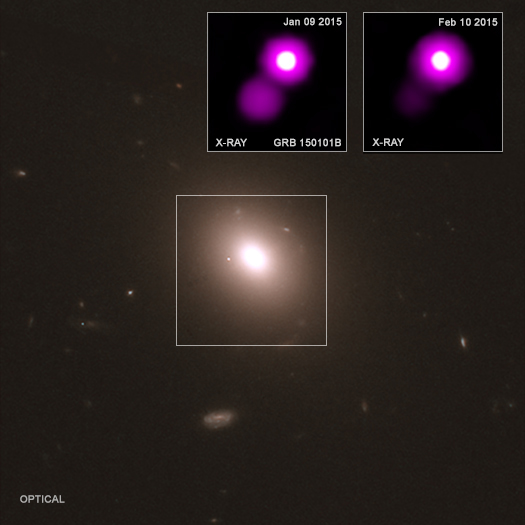Angle Matters: A New Perspective on Neutron Star Collisions Solves an Old Mystery

Eleonora Troja
We are very pleased to welcome Eleonora Troja as our guest blogger. She is an associate research scientist at the University of Maryland, College Park, with a joint appointment at NASA Goddard Space Flight Center. She divides her time between her research on colliding neutron stars, directing the Swift Guest Investigator Program, and her three-year-old daughter, Bianca.
A year ago, on October 16th 2017, an amazing discovery was announced. GW170817, a collision of two neutron stars seen through gravitational waves and light, had realized the perfect union of two worlds. At the press conference organized by the National Science Foundation, a journalist asked an important question to the panelists: “Hadn’t we seen similar events before?” In that moment my mind ran back to an unusual gamma-ray burst, GRB150101B, localized by NASA’s Swift satellite nearly three years earlier.
GRB150101B was a flash of gamma-ray radiation that lasted for less than a fraction of a second. It was one of the weakest explosions ever seen with Swift, yet it was very luminous in X-rays and for a very long time. This was so unusual that Swift scientists were not sure whether the burst was a gamma ray burst (GRB) or another type of weird explosion, and dubbed it with a dual name GRB 150101B / SwiftJ123205.1-1056. I asked that NASA’s Chandra X-ray Observatory observe this object and help us unravel the mystery of its nature. Chandra revealed that there were two sources of X-ray light, not resolved by the Swift observations. A bright X-ray source was located at the center of the galaxy, probably indicating the presence of a supermassive black hole. Next to it, Chandra discovered a weaker X-ray signal coming from GRB150101B. At the same position, telescopes caught a glow of visible light which quickly faded away.
These results helped us narrow down the range of possible explanations for GRB150101B, yet I could not find a satisfactory one. For a long time, I thought this burst of gamma-rays was due to some exotic phenomenon, like a star shredded by a black hole. Several months later, I even re-observed its location with the Discovery Channel Telescope and NASA’s Hubble Space Telescope, to check whether its signal was turning on again. Meanwhile, new stellar explosions presented us with more enigmas to solve, and GRB150101B became a cold case.
It was only in early 2017 that it came to my attention again. It was a period of vivid scientific discussion: a new cycle of LIGO observations had started, new sources of gravitational waves were being detected, and astronomers were wondering whether these objects were emitting light and how it would look like. It was during one of these informal conversations that someone asked me about “off-axis” GRBs. An off-axis GRB is a beam of energy and light not directed straight toward Earth, but tilted at an angle. Although its properties are similar to most GRBs, it looks different to us because of its misalignment. “Bingo!” I thought “What if GRB150101B was a normal GRB which only looked odd because of a bad orientation?” Somehow talking about off-axis GRBs had reminded me of this old object.
I was enthusiastic at the idea – suddenly 90% of the puzzle was solved. The “off-axis” scenario was naturally tying together the data from Swift, Chandra, and Hubble. However, there was one big piece of the puzzle which did not fit: the short-lived glow of visible light. We were suspecting that GRBs could be followed by a very special flash of red light, called kilonova, but the one that followed GRB150101B was too early, too bright, and its color was too blue. Once again, the case ended up in a drawer, but not for long.
A few months later, the discovery of GW170817 taught us a great deal of information about colliding neutron stars and their aftermath, including that they may be followed by a luminous short-lived glow of visible light, a blue kilonova, and a delayed longer-lived X-ray signal, an “off-axis” afterglow. Therefore, when I was asked whether I had seen anything similar before, the last piece of the puzzle suddenly fit into its place and I thought of GRB150101B. Its enigmatic glow could have been a blue kilonova, a flash of radioactive light from the neutron star debris, whereas its unusual look at X-ray and gamma-ray energies was likely the effect of inclination. I ran this idea by my collaborators, and everyone agreed that it could nicely glue together .
GRB150101B was likely a distant cousin of GW170817 and the two of them are not alone, but members of a new and possibly numerous family of astrophysical transients.
- Log in to post comments

